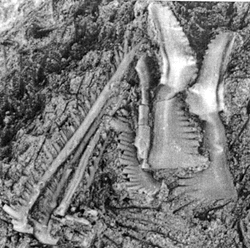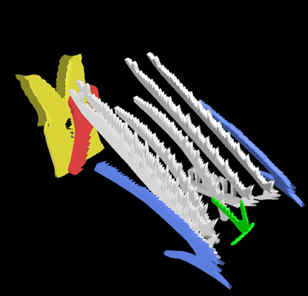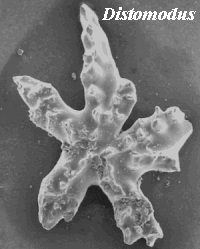
| Palaeos: |  |
Conodonta |
| The Vertebrates | Prioniodontida |
| Page Back | Unit Home | Unit Dendrogram | Unit References | Taxon Index | Page Next |
| Unit Back | Vertebrates Home | Vertebrate Dendrograms | Vertebrate References | Glossary | Unit Next |
|
Abbreviated Dendrogram
Vertebrata |--+--Pteraspidomorphi | `--Gnathostomata | Conodonta |--Paraconodontida `--Euconodonta |--Proconodontidae `--+--Protopanderodontida `--Prioniodontida |--Balognathidae `--+--Prioniodinida `--Ozarkodinida |
Contents
Index |

In earlier sections, we have disposed of the contentious and speculative subject of conodont soft-tissue anatomy. We now belatedly turn to the conodont apparatus itself -- hard tissues about which we have hard data. Specifically, we will describe, albeit briefly and without much detail, the apparatus of ozarkodinid Idiognathodus which is well known from the work of Purnell & Donoghue (1997) and Purnell (1995, 2001, 2001a).
Ozarkodinids, like most euconodonts, have three basic types of elements. These three basic types are the S, M, and P elements. The precise nomenclature has varied considerably over the years. To the extent it makes a difference, we follow the system described by Purnell et al. (2000). The ozarkodinid elements are better differentiated than the elements of many other groups, which makes them convenient to study.
The reader may note that we have made it a point to use certain terminology which is de rigueur in any discussion of conodonts. The point here is not to demonstrate our lamentably poor knowledge of these terms, nor to obscure the facts while purporting to explain them. To the contrary, the objective of our using this "stupid stuff" is, like that of Houseman's Mithradates, to inure the reader to these linguistic poisons by introducing them in small doses and under controlled conditions. [1]
 S-Elements: In the image of an Idiognathodus
natural assemblage at
right, the S-elements are the long, rod-like bones with
straight, transverse pectinate
teeth and a sort of pick-axe at the anterior or rostral end. More
generally, S-elements are frequently curved, as in the Manticolepis model
below. However, they are all relatively simple in shape, relatively
gracile, and with strong longitudinal asymmetry, the base being located much
closer to one end than the other. Each conodont has 4 or 5 mirror-image
pairs of S-elements, numbered S1 to S4 or S5 In
addition, each conodont possesses a symmetrical, unpaired, median S0 element,
shown as green on the figure on the left. The S0 is
an unpaired, bilaterally symmetrical, medial element which is effectively at
least triramous. Two
of its branches create a stout, transverse, rastrate
bar across the bottom of the mouth, denticles facing upward. The S-element numbering system is symmetrically arranged around
this S0
element, with the first element to the left of the S0 designated
S1s, the first to the right S1d, and
so on (with the superscript designations for sinister
and dexter).
S-Elements: In the image of an Idiognathodus
natural assemblage at
right, the S-elements are the long, rod-like bones with
straight, transverse pectinate
teeth and a sort of pick-axe at the anterior or rostral end. More
generally, S-elements are frequently curved, as in the Manticolepis model
below. However, they are all relatively simple in shape, relatively
gracile, and with strong longitudinal asymmetry, the base being located much
closer to one end than the other. Each conodont has 4 or 5 mirror-image
pairs of S-elements, numbered S1 to S4 or S5 In
addition, each conodont possesses a symmetrical, unpaired, median S0 element,
shown as green on the figure on the left. The S0 is
an unpaired, bilaterally symmetrical, medial element which is effectively at
least triramous. Two
of its branches create a stout, transverse, rastrate
bar across the bottom of the mouth, denticles facing upward. The S-element numbering system is symmetrically arranged around
this S0
element, with the first element to the left of the S0 designated
S1s, the first to the right S1d, and
so on (with the superscript designations for sinister
and dexter).
M-Elements: Conodonts have a single pair of M-elements. These are only loosely connected to the S-assemblage and appear to have been attached in the mouth cavity on its dorsal or lateral surface. Their shapes are frequently complex, vaguely reminiscent of anything from a nunchuck to a dart. While the M-elements are structurally obscure, their functional role is clear. They are the fork which held the food item in place as it was sliced or scooped by the S-elements, which acted as a combination knife and spoon.
P-Elements: The P-elements are the stout bones at the right of the right image, the left of the left image, and the bottom of the bottom (Manticolepis) image. Contrary to everyone's expectations, they appear to have been oriented vertically, with the two sets of denticles facing and, in fact, interdigitating as shown in the Idiognathodus natural assemblage. Purnell has produced convincing SEM images showing regular wear facets. The clear implication is that, at least in Idiognathodus, the teeth occluded in a regular and precise way. High resolution images of these facets may be found at Wear on conodont elements.
The Functional Biology of the Idiognathodus Apparatus: Purnell & Donoghue reconstruct the functional biology of the Idiognathodus along the following lines. The S-elements were attached to the medial surface of (at least) two strong lateral cartilaginous plates, by analogy to the oral apparatus of hagfishes and lampreys. The entire apparatus of S- and M-elements was everted over the anteroventral edge of the mouth. In this position, the distal ends of the S-elements would spread out like the ribs of a fan. The S-element denticles (or keratinous "teeth" mounted on them) would grasp and/or slice the food items. The oral plates were then drawn back into the mouth, forcing the S-elements closer together, gripping the food more tightly and forcing it into the oral cavity. The food material was then drawn past the P-elements which crushed, sliced, and sheared it before it was passed to the gut. ATW020728.
Notes: [1] Speaking of stupid stuff, this poem is slightly misquoted at the link, destroying the meter of the critical last two lines. The correct lines are: -- I tell the tale that I heard told. / Mithradates, he died old. Furthermore, contrary to various other web sources, the poem is by Houseman, not by Auden or Yeats. The concluding lines are an ironic reference to Houseman's own To an Athlete Dying Young. The full story behind the poem is interesting, but strains even the elastic notions of relevance which constrain this web site.
Range: Early Ordovician to Middle Triassic (at least)
Phylogeny: Euconodonta:: Protopanderodontida + *: Balognathidae + (Prioniodinida + Ozarkodinida).
Characters: S-elements with hairpin shape; S-elements oriented with cusps rostral and denticles obliquely dorsal [P+00]; P elements less massive & more angular; 3 pairs of P elements; apparatus probably eversible.
Links: confabs98.html; Jerzy Dzik's home page.
References: Purnell et al. (2000) [P+00]. APW040316.
 Balognathidae:
Distomodus, Icriodella, Icriodus
Balognathidae:
Distomodus, Icriodella, Icriodus
Range: from the Middle Ordovician (fl.Llandovery) to Early Devonian
Phylogeny: Prioniodontida: (Prioniodinida + Ozarkodinida) + *.
Note: according to a recent (June, 2003) Pander Society Newsletter, an analysis of the Distomodus apparatus is nearing completion.
Image: Distomodus Pa element. From Conodonts and originally from Leicester University.
Links: Conodonts; PALAEONTOLOGIA POLONICA, vol. 58; APW040316.
Prioniodinida: Gondolella, Hibbardella, Idioprioniodus, Kladognathus, Neogondolella, Phragmodus, Promissum.
Range:
Phylogeny: Prioniodontida:: Ozarkodinida + *.
Links: Prioniodinida; PAN 51.(abstracts of Dhanda and Purnell & von Bitter); ALBE R IANA T. APW040316.
Range:
Phylogeny: Prioniodontida:: Prioniodinida + *.
Links: Ozarkodinida; Muzeum Geologiczne - Konodont; abstract; PandD 97.pdf;. APW040316.
| Page Back | Unit Home | Page Top | Page Next |
checked APW040316.